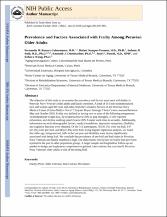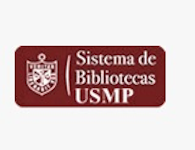Prevalence and Factors Associated with Frailty Among Peruvian Older Adults

Ver/
Trabajo
(application/pdf: 47.00Kb)
(application/pdf: 47.00Kb)
Fecha
2014-01-01Autor(es)
Runzer Colmenares, Fernando M.
Samper Ternent, Rafael
Al Snih, Soham
Ottenbacher, Kenneth J.
Parodi García, José Francisco
Wong, Rebeca
Metadatos
Mostrar el registro completo del ítemResumen
The objective of this study is to examine the prevalence and factors associated with frailty in
Peruvian Navy Veteran's older adults and family members. A total of 311 non-institutionalized
men and women aged 60 years and older, from the Geriatrics Service of the Peruvian Navy
Medical Center (Centro Médico Naval “Cirujano Mayor Santiago Távara”) were assessed between
May and October 2010. Frailty was defined as having two or more of the following components:
1) unintentional weight-loss, 2) weakness (lowest 20% in grip-strength), 3) self-reported
exhaustion, and 4) slow walking speed (lowest 20% 8-meter walk-time in seconds). Additionally,
information on socio-demographic factors, medical conditions, depressive symptoms, disability,
and cognitive function were obtained. Of the 311 participants, 78 (25.1%) were not frail, 147
(47.3%) were pre-frail, and 86 (27.8%) were frail. Using logistic regression analysis, we found
that older age, being married, falls in the last year and disability were factors significantly
associated with being frail. We conclude that prevalence of pre-frail and frail status in Peruvian
Navy Veterans and family members is high. Our data reports risk factors for frailty that have been
reported in the past in other population groups. A larger sample and longitudinal follow-up are
needed to design and implement comprehensive geriatric interventions that can benefit Peruvian
Navy Veteran's older adults at risk of becoming frail.
Colecciones
- Artículos [274]
Materias
Editor
Archives of Gerontology and Geriatrics
Acceso
info:eu-repo/semantics/openAccess
Financiamiento
National Institute on Aging of the National
Institutes of Health (Older Americans Independence Center)
Recurso(s) relacionado(s)
https://doi.org/10.1016/j.archger.2013.07.005http://www.ncbi.nlm.nih.gov/pmc/articles/PMC3808461/







